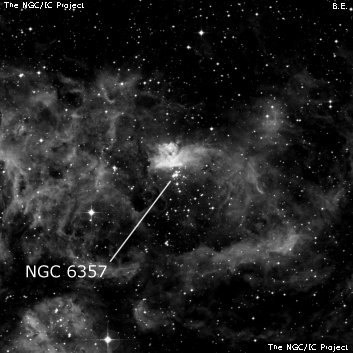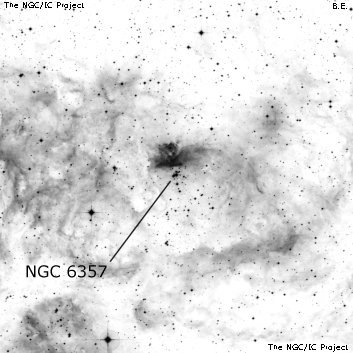NGC/IC Project Restoration Effort
(This is a very very beta version)
NGC6357


Basic Information
Location and Magnitude
Right Ascension: 17:24:43.5
Declination: -34:12:5
Constellation: SCO
Visual Magnitude:
Historic Information
Discoverer: Herschel J.
Year of discovery: 1837
Discovery aperture: 18.3
Observational
Summary description: F, L, E, vglbM, D * inv
Sub-type: EN+OCL
Steve's Notes
=====
NGC 6357
18" (7/16/07): at 115x a faint elongated hazy glow was visible just north of a nice 15" pair of mag 11/12 stars. Adding an OIII filter dramatically improves this HII region and shows a bright, elongated nebulosity oriented WSW-ENE, ~5'x2'. Appears brighter in the middle just north of the double star. A faint star is off the north side, oppositely placed from the double. At 174x the nebula is slightly brighter and clumpy in the middle on the south side and a couple of very small slightly brighter knots are occasionally visible. The group of stars to the south (including the double) is catalogued as Pismis 24. Only the brightest portion of this huge HII complex was noticed. NGC 6357 is located 8' WNW of mag 7 HD 157528 and this star is the northernmost of a 27' line of four mag 6-7 stars that extends to the south (nicknamed "Las Cuatro Juanitas" in Chile). NGC 6334, the Cat's Paw Nebula, lies two degrees southwest..
17.5" (5/30/92): at 82x using an OIII filter, this emission nebula is a bright, distinctive object, elongated 3:1 E-W, 4.0'x1.5'. A close mag 11/12 double star is at the south edge. The whole field appears weakly nebulous and the nebulosity is just very faintly visible without a filter at 220x. Excellent contrast gain with the OIII filter! A group of a dozen faint stars is just south (= Pismis 24) including a double star. This nebula is associated with the Wolf-Rayet star HD 157504 = WR 93, which is located east of the bright section.



